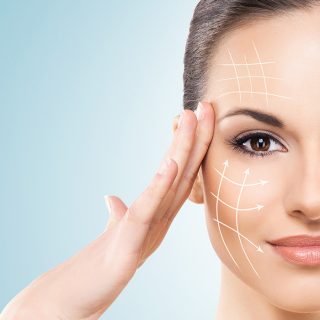The operation is usually very successful. Recognised limitations / unwanted side effects include changes in the sensation over the scalp, caused by injury to the nerves as they pass from the eyebrow backwards to the top of the scalp – especially behind the scars.
1 Bleeding / haematoma (collection of blood): this complication applies to almost any surgery. It generally occurs within the first 12 hours after surgery and usually needs a return visit to the operating theatre to drain any collection of blood and attain control of any bleeding points under general anaesthesia. The risk of this is approximately in the order of 1 in 100.
2 Wound infection: it is uncommon (~1% or less) to have infection following a brow lift, because of sterile instrumentation, wound preparation and antibiotics are used before surgery. If it develops it is treated with further antibiotics and appropriate wound care.
3 Poor scarring: some individuals may develop thick and red scars, so-called hypertrophic scarring. Rarely this may progress to keloid scars. These unfavourable scars can be treated with steroids and sometimes may have to have surgical revision.
4 Hair loss: this is uncommon and may occur as a result of tension, swelling in the scalp or as a general reaction to the trauma of surgery – more so with repeated excisional (e.g. temporal or coronal) brow lifts. Wound infection can also cause temporary hair loss in the vicinity of the wound. Fortunately, in most cases, hairloss is reversible but may take many months to resolve.
5 Numbness of small areas of skin or scalp follows most brow-lifting surgical procedures and gradually decreases with time. Some techniques e.g. coronal brow lift can leave permanent numbness above the scar for which there is no remedy, but is generally well accepted and tolerated by patients who have chosen this technique.
6 Bruising: this is a normal sequel to surgery and, therefore, is not a complication. The duration of bruising can vary from about two to three (rarely up to twelve) weeks and depends on the extent and thickness of skin, among other factors.
7 Asymmetry: most patients have some minor facial asymmetry at the outset and most of these cannot be fully corrected by brow lifting. Any concerns about asymmetry should be discussed with your surgeon.
8 Weakness of the muscles which lift the eyebrow on one side or both sides – which can be temporary or possibly permanent has been reported as a recognised complication.
9 Unfavourable result: the outcome of this operation depends on many factors including expectations. Your surgeon can only achieve what is possible within his / her limitations. In spite of a good result and absence of complications some patients feel aggrieved. Further surgery may not necessarily help – with either the same or a different surgeon.
A brow lift does not stop the clock, but it does put the clock back. The freshening effect of the brow lift is likely to always be there, in that you should not look as old as you would have done if it had not been carried out.



